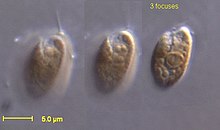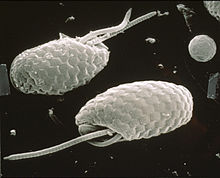Cryptomonad
| Cryptomonads | |
|---|---|

| |
| Rhodomonas salina | |
Eukaryota )
| |
| Domain: | Eukaryota |
| (unranked): | |
| (unranked): | |
| Phylum: | Cryptophyta Cavalier-Smith, 1986
|
| Classes & orders | |
| Synonyms | |
| |
The cryptomonads (or cryptophytes)
Some may exhibit
Characteristics
Cryptomonads are distinguished by the presence of characteristic extrusomes called ejectosomes, which consist of two connected spiral ribbons held under tension.[4] If the cells are irritated either by mechanical, chemical or light stress, they discharge, propelling the cell in a zig-zag course away from the disturbance. Large ejectosomes, visible under the light microscope, are associated with the pocket; smaller ones occur underneath the periplast, the cryptophyte-specific cell surrounding.[5][6]
Except for the class
A few cryptomonads, such as
Classification

The first mention of cryptomonads appears to have been made by
One suggested grouping is as follows: (1)
References
- ISBN 978-0-632-04761-1.
- PMID 18397952.
- ^ "Cryptophyta - the cryptomonads". Archived from the original on 2011-06-10. Retrieved 2009-06-02.
- ISBN 9780321559654.
- PMID 6155157.
- PMID 6470985.
- ^ Nuclear genome sequence of the plastid-lacking cryptomonad Goniomonas avonlea provides insights into the evolution of secondary plastids
- PMID 11323671.
- PMID 10430868.
- ^ Novarino, G. (2012). "Cryptomonad taxonomy in the 21st century: The first 200 years". Phycological Reports: Current Advances in Algal Taxonomy and Its Applications: Phylogenetic, Ecological and Applied Perspective: 19–52. Retrieved 2018-10-16.
- PMID 30482201.
- PMID 21810989.
- PMID 26817772.
- .
- ^ "Cryptomonads". Retrieved 2009-06-24.
